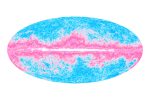
© 2021 Jonathan Feldschuh
Imagination is more important than knowledge. For knowledge is limited to all we know and understand, while imagination embraces the entire world.
—Albert Einstein
Walking into Jonathan’s studio one feels an immediate flow of energy: the colors are intense, the strokes are bold, there is an immediate sense of purpose and exploration. Hung high on the non-working wall are two dream-like paintings of the Large Hadron Collider at CERN in Switzerland, a miraculous feat of cooperative science that contains the world’s largest and most powerful particle accelerator. Facing them are large images painted on mylar inspired by particle theory, a dynamic imagining of the interactions of minuscule particles rooted in the specific mathematical formulas that govern their actions.
Jonathan Feldschuh, an artist based in New York, received a degree in Physics from Harvard University before pursuing his career as a painter. While still at university, Feldschuh had an epiphany. Recognizing that the study of physics was not going to be his life’s path, he began taking as many art classes as possible, balancing the two pursuits through graduation. He then moved to Prague for three years determined to get a classical art education that was not easily available in the States. More focused on the formal qualities of art, the Academy of Fine Arts in Prague was where he learned to draw and to fully understand the traditional aspects of modern and contemporary art.
At their core, both art and science are about observation and interpretation. For Jonathan, physics is more than just a collection of difficult facts to be learned, it is a way of looking at the universe, an approach to understanding and experiencing the world around us. He is interested in capturing the infinitesimally small realms that underlie everything, subatomic interactions that have their own very precise set of abstract rules. In his own words, he went down the road of seeking a visceral understanding of what the universe is like at this essential level, determined to make it visible and dynamic.
This exhibition at 1GAP Gallery features 3 large-scale paintings of particle accelerators, notably called the “gothic cathedral of the 20th century” by physicist Victor Weisskopf. These paintings are drawn in pencil and acrylic washes on both sides of translucent mylar, radiating light and fusing “organic and inorganic structures, articulating chance patterns with drawn lines.” The scale of the paintings is an homage to the dramatic CinemaScope format used in the Hollywood epics of his childhood, highlighting the ongoing drama of the high-speed interactions taking place inside the collider. Work from Particles depicts Jonathan’s interpretation of the moment of impact among these tiny unseen particles, giving us a window into an invisible universe. Also painted on both sides of mylar, Particles captures the intensity of these high-energy collisions, forcefully using the language of pure abstraction and a palette that is intuitive, deeply personal and often unexpected. These works allow us entry into a world that exists both around us and within us, the unseen basis of all we know and experience.
Jonathan Feldschuh (b. 1964, New York City) has had numerous exhibitions, notably a solo show at the National Academy of Sciences in Washington, DC which traveled to 4 additional venues. He has also had solo shows at Mixed Greens Project Space (NYC), Galerie Vernon & Vernon Projekt (Prague), Cynthia Broan Gallery (NYC), and Marella Arte Contemporanea, (Como, Italy) among others. His work has been included numerous group shows in the US, Italy, Canada, and the UK, most recently in Citizen/Artist at TCNJ Gallery in New Jersey, which traveled to Northeastern University in Boston.
Fran Kaufman, September 2021
Please contact Fran Kaufman at fran@kv-projects.com to schedule an appointment and for additional information.

© 2021 Jonathan Feldschuh